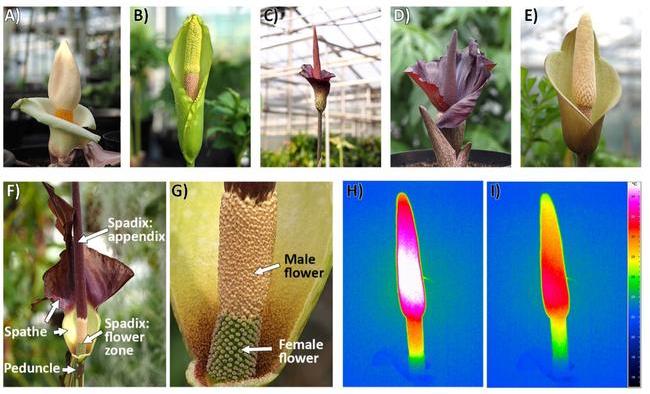TPJ August 2023 Editor choice
Research Highlight for Patterns and drivers of heat production in the plant genus Amorphophallus
https://doi.org/10.1111/tpj.16343
A hot topic: thermogenesis in Amorphophallus
Thermogenesis is the ability to increase metabolic rate in order to elevate body temperature or the temperature of specific organs or tissues, and is mostly known from animals, especially mammals and birds. But flowers in several plant species are also able to metabolically raise their temperature. The Araceae, also known as the Arum family, has a high number of known thermogenic genera and species, with thermogenesis occuring during anthesis and only in male flowers and their derivatives as a means of attracting pollinators. Amorphophallus, with around 240 species, is one of the largest genera in the Araceae family. Inflorescences throughout the genus vary in dimension, colour, shape and odour (Figure 1A-E).
Claudel et al. measured the inflorescence temperatures of 80 Amorphophallus species. The inflorescence consists of a sheathing bract, called the spathe, covering a flower spike with a fleshy axis, termed the spadix. The spadix consists of the appendix and the flower zone at the base, the base forming a floral chamber within the spathe. The flower zone can be further divided into the upper male part and the lower female part (Figure 1 F, G). The authors measured the temperature in the male flower every 5 minutes across 2-3 weeks, long enough to capture the full process of anthesis, and recorded time-lapse movies based on thermal images for some species. Thermogenesis is a very dynamic trait, therefore including full temporal trajectories of temperatures was better for classifying the thermogenic patterns into types that reflect the biological differences, rather than only measuring a single parameter, such as the peak of temperature elevation.
They observed a multitude of temperature patterns throughout the genus, with different temperature ranges, different numbers of peaks and peak patterns in the appendix and male flower zone. In several species, the beginning of anthesis was marked by a thermogenic peak in the appendix, while the end of anthesis was marked by a drop in temperature in the male flower zone, perhaps due to evaporative heat loss through the open pores or slits of the anthers after pollen extrusion (Figure 1 H, I).
The authors then analysed the diversification dynamics and found that the diversification rate of Amorphophallus, measured as a balance of speciation and extinction, decreased over evolutionary time, and that thermogenesis did not influence the rate of species diversification within the genus, suggesting that thermogenesis was not a determining factor for evolutionary success. Reconstruction of the ancestral state of thermogenic activity suggested that thermogenic capacity had a single origin in Amorphophallus, but was then lost in several species in several subclades.
Given the diversity of inflorescences in Amorphophallus, it is possible that thermogenesis influenced the evolution of inflorescence morphology. Indeed, three traits related to inflorescence width were linked to thermogenesis and suggested that a tendency for thermogenesis is stronger in species with shorter, thicker inflorescences. This floral shape is a typical adaptation to beetle pollination, so the thick and warmer inflorescences might attract beetle pollinators in Amorphophallus. Thermogenesis might serve as a heat reward for the pollinators, by increasing the body temperature of the pollinator or by creating a heated floral chamber attractive to pollinators. Another function of thermogenesis could be improved scent volatilisation during stigma receptivity.
Taken together, Claudel et al. speculate that the function of thermogenesis in Amorphophallus is not fixed and universal, but rather varies depending on the ecology and geographic distribution of a given species.

Figure 1: Thermogenesis in the flowers of Amorphophallus.
A-E) Diversity of flower morphology in Amorphophallus. A. Prainii (A), A. Napalensis (B), A. Konjac (C), A. Mossambicensis (D) A. Fuscus (E).
F-G) Flower structure of A. declinatus (F) and magnification of its flower zone in the female phase (G).
H-I) Thermogenic profile of an A. fuscus flower at the beginning of anthesis (H) and one hour later (I); photographs (A-E) by Cyrille Claudel, photographs and thermographs (F-I) modified from (Claudel et al., 2023).




